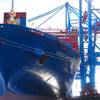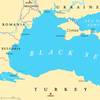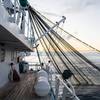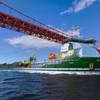Stena’s Ro-Pax Vessel with Wärtsilä Propellers Obtains DNV Silent Operations Notation
Stena’s new Ro-Pax vessel, Ala’suinu, equipped with Wärtsilä propellers has received DNV’s Silent(E) notation, issued to vessels that demonstrate the ability to effectively reduce emissions of underwater radiated noise.
Technology group Wärtsilä has designed and delivered controllable pitch propellers for Stena’s new Ro-Pax vessel, Ala’suinu, which has successfully completed sea trials.
Following these sea trials, Ala’suinu became the first Ro-Pax vessel to fulfil the DNV Silent(E) notation, satisfying the criteria in the operating conditions at 11 and 18 knots.
The Ala’suinu, which was built at CMJL Shipyard (Weihai) in China, is under a five-year lease to Marine Atlantic, a Canadian operator based in province of Newfoundland & Labrador.
Environmental sustainability was a prime consideration in the design of the 203 meters-long ship, which will sail between Nova Scotia and the island of Newfoundland from June 2024.
“The Ala’suinu is a specially designed vessel for Marine Atlantic. We are fully committed to reducing the environmental impact of our operations, and in this vessel another dimension of sustainability has been added. The dedicated Wärtsilä propeller design enables us to minimize underwater noise for the benefit of marine life off Canada's coasts,” said Anderson Noel, Marine Atlantic’s Director of Fleet Operations.
“With this notation, Stena and Wärtsilä are showcasing their commitment to taking proactive steps to reduce shipping's environmental footprint. Despite Ro-Pax being a challenging ship type from an underwater noise perspective, this innovative machinery configuration has enabled a propulsion plant with sufficiently low noise emissions to satisfy our voluntary class notation Silent(E),” adeds Øystein Solheim Pettersen, Head of Section, Noise and Vibration - DNV.
During the design process of the controllable pitch propeller, Wärtsilä’s in-house design experts paid special attention to underwater radiated noise as a key design parameter.
This was done without compromising on other important propeller design requirements, such as ensuring optimal performance and efficiency, for example.
As well as reducing emissions of underwater radiated noise, Wärtsilä’s propeller ensures that owners and operators gain the benefits of lower operating costs and a reduced environmental footprint through less fuel consumption and fewer exhaust emissions, according to the company.














